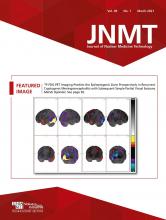Abstract
Respiratory motion artifacts may affect interpretation of whole-body 18F-FDG PET/CT scans, especially when lesions are localized between the liver and the lung. We report a case of a patient with breast cancer who underwent PET/CT after therapy and in whom focal 18F-FDG uptake of equivocal interpretation was observed between the liver and the pleura. A subsequent imaging acquisition of the right lateral decubitus showed that the lesion had a pleural location, thus improving the diagnostic accuracy of the PET/CT finding.
Bone, liver, lung, and brain are common metastatic sites in breast cancer and are often evaluated by 18F-FDG PET/CT for a metabolic characterization (1).
CASE REPORT
A 50-y-old woman with a history of left breast cancer previously treated with mastectomy and axillary lymph node dissection underwent 18F-FDG PET/CT for suspected splenic and lung metastases. PET/CT images were acquired 60 min after intravenous injection of a 3.5 MBq/kg dose of 18F-FDG on a GE Healthcare Discovery 690 64-slice tomograph (40-mAs low-dose CT, 120 kV, 2.5 min per bed position, 256 × 256 matrix, 70-cm field of view) and revealed a focal increase in uptake between the liver and the pleura of unclear origin, suggestive of metastatic disease (Fig. 1).
Anterior maximum-intensity projection (A) and axial 18F-FDG PET (B) and PET/CT (C) images show focal hypermetabolic activity on right side between liver and pleura.
Subsequently, a second segmental acquisition was performed with the patient in the right lateral decubitus position, which allowed displacement of the liver away from the chest wall and showed that the lesion originated from the pleura (Figs. 2A and 2B). A subsequent high-dose CT scan confirmed the pleural location (Fig. 2C).
Axial maximum-intensity projection (A) and axial PET/CT (B) image with patient positioned on right side show that lesion (arrows) was pleural; subsequently, high-dose CT (C) confirmed pleural location.
DISCUSSION
Respiratory motion on PET/CT scans can cause lesions to be missed or dislocated along the diaphragm, determining a systematic decrease in SUV measurements (2). Also, small-lesion detection can be hampered by diaphragmatic motion, which causes an internal shift in organs that introduces image artifacts, image blurring, and a consequent lower ability to detect (due to the partial-volume effect) and locate lesions. The region between the liver and the lung is particularly sensitive to motion artifacts, with frequent difficulty or errors in attributing findings to specific anatomic territories. Another limitation of PET/CT is the low spatial resolution (about 5 mm) of conventional scanners, potentially causing quantitative distortions and reduced sensitivity due to the partial-volume effect (3).
The main technical solutions available to manage respiratory motion artifacts in PET/CT studies are hardware or software technologies provided by several vendors with different definitions (respiratory gating, motion-free, end-expiration, banana artifact management, and data-driven gating), which show a benefit in terms of image quality, quantification, and diagnostic sensitivity. However, patient compliance, long acquisition times, and unavailability of these techniques represent major limitations (4).
In this case, we applied a different acquisition method to manage this artifact. After the whole-body acquisition, the patient was placed in the right lateral decubitus position and a segmental scan was acquired. This positioning permitted separation of the pleura from the liver, showing that the lesion was pleural, and increased diagnostic and quantitative accuracy: the SUVmax increased from 7 in whole-body scanning to 7.5 in the modified acquisition posture (Figs. 2A and 2B). Evaluating the SUVmax, we found the delayed time between the 2 acquisitions to be 6 min; this is a factor to take into account.
CONCLUSION
This case illustrates a possible way to manage PET/CT scan artifacts during free breathing and the consequent difficult and unclear definition of the anatomic pertinence of focal uptake in peripheral lung regions or, alternatively, in pleura or liver. This approach is simple, cost-free, and available in all labs even if not equipped with the latest generation of PET/CT scanners.
DISCLOSURE
No potential conflict of interest relevant to this article was reported.
Footnotes
Published online Oct. 5, 2020.
- Received for publication June 23, 2020.
- Accepted for publication September 2, 2020.









